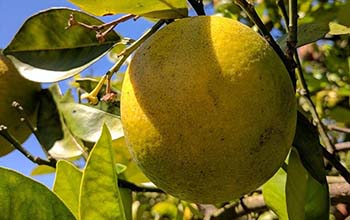
Research News
Disease is devastating the citrus industry
March 26, 2020
Citrus greening, also called Huanglongbing, is devastating the citrus industry. Florida alone has experienced a 50% to 75% reduction in citrus production. There are no resistant varieties of citrus plants available, and limited disease control measures exist.
Some scientists think even orange juice could one day become as expensive and rare as caviar. Now National Science Foundation-funded plant pathologists at the University of California, Berkeley and the U.S. Department of Agriculture are conducting research into ways to boost citrus immunity and protect the valuable fruit against citrus greening.
Because the bacteria that cause citrus greening cannot be grown in a lab, scientists need to find novel ways to conduct experiments. The University of California, Berkeley/USDA team looked at bacteria strains that cause citrus greening to see if peptides (a compound of two or more amino acids) could be identified that would trigger immune responses.
“That was a long list, so we narrowed it down by selecting small peptides that were a bit different in their peptide sequence, which might imply that the bacterium had made those sequence changes so that they wouldn’t be recognized by the plant immune system,” said Jennifer Lewis, leader of the research team. “Then we narrowed the list to peptides from strains that caused disease in citrus.”
The scientists showed that two particular peptides could trigger immune responses in multiple plant species, including citrus. These peptides may play a role in preventing or reducing yield loss from citrus greening.
“We thought it was especially interesting that some of the peptides predicted to elicit a response could trigger immune responses in multiple plant species,” said Lewis. “This suggests that the immune response to these peptides is conserved across species.”
The research is published in the March issue of Molecular Plant-Microbe Interactions.
“For the past 15 years, citrus greening has been evolving as one of the most important, and damaging, diseases in U.S. agriculture,” said Brad Day, a program director in NSF’s Division of Integrative Organismal Systems. “This pathogen has proven difficult to defeat, both in terms of early detection and in management. As one strategy for helping citrus trees, this work may hold the key not only to fighting this disease, but also to understanding and developing sustainable measures to ensure this crop is protected for years to come.”
—
NSF Public Affairs,
researchnews@nsf.gov
Source: NSF News
Brought to you by China News







